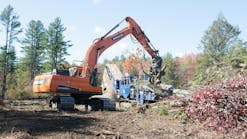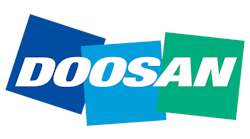Being “rode hard and put up wet” is an old western horseman’s phrase referring to riders who worked their horses into a solid lather and then sent them to their stalls without any grooming to make them feel more comfortable. Similarly, some contractors like to “cowboy” their scrapers. As a towed scraper is one of the simpler pieces of machinery on a site, sometimes it’s taken for granted and not given nearly the maintenance attention it requires. And, arguably, that strategy will certainly shorten scraper performance life. With that said, what are the key factors involved in extending the useful life of the unit? We asked several scraper manufacturers to share their top tips on towed scraper maintenance and operation.
Caterpillar Inc.
“Proper application is the single most important factor in extending the life of a towed scraper and its pulling tractor,” says Dan Bruch of hauling systems marketing at Caterpillar Inc. “Using the wrong system not only decreases the life of the equipment, but will reduce productivity and can severely impact the profit from a given job.”
To select the proper hauling system, Bruch says, a contractor must be able to answer the following questions:
- What type of material is being moved?
- What are the underfoot conditions?
- How much material has to be moved?
- What is the total job cycle distance?
- What are the job-site time/production requirements?
Bruch explains that towed scrapers are best suited for dirt and sand applications with bank densities of less than 3,200 pounds. Using towed scrapers in rocky conditions will shorten the life of the cutting edges, bowl, and tires. “For towed scrapers pulled by steel track–type tractors, we recommend keeping the loaded haul distance at less than 1,000 feet,” he says. “For tired or rubber-tracked agricultural tractors pulling towed scrapers, we recommend keeping the loaded haul distance under 4,000 feet. For applications with longer hauls, higher-density materials, or rocky conditions, Caterpillar recommends the use of an alternative hauling system such as a wheel tractor-scrapers or articulated trucks.”
It’s also important to use the proper hauling system for the specific conditions on a job site. Consider that more than one type of hauling system may be required as job-site conditions change. “Avoid excessive speeds on poorly maintained haul roads that cause scraper bounce, as this can cause excessive stress to the scraper as well as the pulling tractor,” says Bruch.
“And be sure to follow proper loading techniques. Towed scrapers are designed to load at higher speeds (between 4.5 and 6.5 miles per hour) with shallow cuts of 3 to 5 inches. A cut requiring speeds less than 4 miles per hour is probably too deep. And avoid turning while loading. Even if push loading is approved for a certain towed scraper, I recommend that this is done on a limited basis as the cost per yard and stress factors increase in these tough loading applications,” he says.
As to daily maintenance, Bruch stresses following the manufacturer’s daily maintenance recommendations. “Perform a thorough walk-around inspection prior to use,” he says. “The scraper should be thoroughly examined for worn or damaged parts, and hydraulic leaks at the couplers, hoses, and cylinders. Check the condition of the tires and make sure that they are properly inflated. Excess tire pressure can lead to more scraper ‘bounce’ at higher speeds. Insufficient tire pressure can lead to increased tire sidewall pressure and ultimately shorter tire life.”
According to Bruch, Cat-towed scrapers offer several features to minimize or facilitate maintenance. For example, Cat-towed scrapers require only weekly greasing, while other models may require daily greasing. Also, Cat units feature reversible cutting edges that can be rotated 180-degrees when one side is worn to double the life of the cutting edge. When worn, router bits can be lowered for extended life. The ejector-floor rollers have sealed bearings that do not require greasing. Ultrahigh molecular weight (UHMW) plastic is used in place of ejector guide rollers, again to eliminate the need for lubrication. Finally, he says, all maintenance areas are accessible from ground level, making maintenance safe and easy.
Regarding scraper parts, Bruch says that contractors should keep cutting edges and router bits on hand. “But towed scraper users are not large parts consumers. A good dealer backed by a strong manufacturer should be able to provide adequate parts support to prevent the contractor from being required to stock other service parts,” he says.
Bruch adds that the dealer should be there to assist contractors with job-site evaluation and equipment selection to make sure that they are using the best earthmoving system for a given application. “Once this is established, operator training is of the utmost importance to minimize machine maintenance, reduce downtime, and increase productivity,” he says. “Cat dealers offer customer support agreements to help contractors manage their machine maintenance.”
Ashland Industries“The biggest initiative affecting performance life is operator education,” says Randy Rust, president of Ashland Industries. “Operators must know the limits of the tractor and the scraper and must run the machinery in the way its design intended. Don’t ‘hot rod’ the units. And, you have to understand the differences between how to run a self-propelled unit and a towed unit.”
Next, Rust says, contractors should pay close attention to the design of the scraper. Is it engineered for ease of maintenance and heavy-duty performance? “For example, regarding the areas where we have pivoting joints, we use self-lubricating bushings to increase life expectancy. Also, pivot joints should be easily accessible,” he says.
Rust also says that Ashland designs its machines in the most efficient way to raise the bowl or apron. “We position our lift cylinders vertically over the cutting edges,” he says. “By having the cylinders standing vertically, and raising the scraper bowl vertically, we don’t see any stress and strain on the frames of the machines versus running cylinders placed horizontally. There is a lot of stress that can be exerted on a framework by extending a cylinder horizontally to raise a blade vertically.”
Another thing that really contributes to longevity, says Rust, is the rolling resistance of the tires. “You can never have enough flotation. If you keep the rolling resistance very low, the machine will roll along very easily in all types of conditions. If you run a smaller tire, there is a higher rolling resistance, and that is much harder on the tractor and the scraper. A taller, larger tire is easier on the tractor’s drive train,” he says.
Rust says it’s important to keep the right parts on hand. “There is a lot of stress placed on the hitches, especially on the large format scrapers—so having hitch pins and bushings available for rebuilding those hitches is very helpful,” he says.
Paying close attention to the hydraulic couplers on the front connecting hoses is also a key factor. “All the tractor companies are using electronically controlled hydraulic couplers, which are fitted with tips, on the hydraulic hose. There is a plunger that hits this tip—and we’re seeing tip failures because it is hit with such velocity. So if one function isn’t working on the scraper, the first place the operator needs to look at is the coupler between the scraper and the tractor. Any time you send a machine out, you should have some tips with you,” says Rust.
As for daily in-the-field maintenance, Rust covers a checklist for the walk-around of the scraper.
He begins by inspecting the hitch pin under the tractor and making sure that the hitch is securely connected onto the scraper tractor’s drawbar. Make sure that the multiple bolts that secure the hitch are tight.
Examine the front connecting hoses that connect the scraper to the tractor. Hoses should not be getting caught in any framework on tight turns as the machine is rotating through the day. Hoses should be held up and out of the way. “We offer as standard a large hydraulic hose holder which keeps the hoses elevated away from the hitch,” he says. “If running tandem, check the connection between the front scraper and the rear scraper. Check hoses as well,” he adds.
Rust cautions against debris buildup. “Remove any large dirt chunks, especially any chunks near pivoting areas or in areas where they might damage hydraulic cylinder rods. As you get to the back of the scraper, check for any large deposits or dirt that would interfere with the ejector moving forward and back. Sometimes dirt will fall over to the back of the scraper and sit on the dirt shield. If you don’t get that removed, it will fall into the ejector area and cause binding, or it may even break off the brake lines.”
Also, Rust recommends removing any material or rocks that may build up near the framework or between the tires. Rocks could cut the sidewalls of the tires. “We have designed our scrapers with a good clearance between the frames and the tires,” he says.
When top loading the scraper with an excavator, Rust says, it is very important to lower the scraper fully to the ground before dropping dirt into it, so that one is not putting a shock load into the hydraulic circuit. “If 6 yards of dirt is being dropped from 15 feet above, all the pressure spike gets sent into the pins or into the tractor, too,” he says.
Finally, Rust says, the use of standardized components makes maintenance much easier. “We use nominal-sized pins and bushings. We’re not running metric bolts or pins. These components are readily available through any decent supplier. Cutting edges for our units are available through most aftermarket blade suppliers. A lot of models will require a specific blade and the customers are held captive to buying the blades from that manufacturer. Their blades may not have a common bolt pattern. On the other hand, a lot of our component parts are available over the counter—from our cutting edges, to bolts and bushings, and valve cartridges. Standardized components make it easier for operation and repair. We offer a user friendly unit.”
Miskin Scraper Works Inc.
“In the maintenance arena, there is a love/hate relationship with greasing. Some love grease and grease every day, while others hate grease and avoid it at all costs. There seems to be no medium,” says Rick Sanders, customer service manager for Miskin Scraper Works Inc.
Sanders says that Miskin goes to great lengths to design its machines for ease of maintenance. The units are engineered with hardened bushings, which is a good thing for those who choose to grease less, he says. All grease fittings are accessible from the ground, and the scraper does not have to be operated or cycled to reach its grease fittings. Standard replacement parts from companies like Timken & Parker are readily available worldwide.
Regarding parts, Sanders says cutting edges and blades in particular should be stocked, especially when the job site involves highly abrasive sandy soil environments where cutting edges wear out much more quickly. “Blades are very heavy and are costly to ship. There are only a handful of blade manufacturers in North America, so replacements may not be readily available. It’s best to stock blades to avoid downtime. Plus, the wear items and the fasteners for them need to be inventoried as well. Most scraper blades are reversible, and operators may get only 100 hours on one edge.
The savvy operator will order a set of blades at the time that he has flipped the blades,” he says.
Bottom line—Sanders lists his top tips in extending performance life as the following:
- Complete daily lubrication.
- Follow the manufacturer’s operations and maintenance manual.
- Replace such ground-wear items as blades and cutting edges before excessive wear can cause costly damage to the
support frame. - Properly match the scraper and tractor to the job.
Beyond the latter, Sanders stresses buying a heavy-duty scraper. According to Miskin, its D-Series Scrapers (19-yard and 26-yard) are made heavier for today’s high-speed, high-horsepower industrial tractors. The Accumulator Cushion Ride feature dampens the worst bumps and jolts for increased operator comfort and faster production cycles. The unit boasts such maintenance, wear, and safety features as oil-filled hubs, safety lighting, larger pins, wear bushings, thicker cutting edges, and high-speed hydraulics.
K-Tec Earthmovers
“The number-one factor in performance life is the structural design of the scraper,” says Kelly Goossen, in-house sales and marketing manager for K-Tec Earthmovers of Manitoba.
“Our scrapers are constructed using 80% Hardox and Weldox Swedish steel, making the unit one of the toughest and lightest scrapers on the market. Also, our company was founded by people with hands-on experience in earthmoving,” he says.
Since its inception in 2000, Goossen says, K-Tec has made great strides to engineer innovative maintenance and wear features into its models.
The company says that while the competitor’s scrapers require 12–25 grease points to be serviced twice daily, K-Tec earthmovers can be serviced in only minutes per day. With only two easy-access grease points that require servicing once a day, the other four grease points, which are on the rear axle, only require greasing every 250 hours, or about every three weeks. Greaseless bushings on all other hinge points can run up to 1,200 hours before needing to be replaced.
K-Tec’s hitching systems distribute the load weight to take greatest advantage of the pulling unit’s power, says the company, while minimizing stress on the hitching tongue. With most of the K-Tec earthmovers, 75% of the weight is transferred to the scraper’s axles, placing less stress on the tractor’s rear axle.
According to K-Tec, its scrapers also feature a larger gate opening, over 28 inches of ground-to-blade clearance, faster ejector times, high flotation, and lightweight, durable operation.
Education Is Everything
Manufacturers agree that despite all the engineering and design parameters of a given scraper, the unit requires a good operator. Training is important to get the most from the machine. In 2009, wheel-tractor-scraper operating training entered the digital age. You can check it out at www.catsimulators.com or even on www.youtube.com.
The new Cat Wheel-Tractor-Scraper simulator features the latest in 3D graphics designed to deliver a state-of-the-art training experience complete with a virtual walk-around safety inspection. Instructors can program up to 105 fault points to test operator knowledge. According to Cat, using simulators means that new operators can begin training before they drive actual machines, while experienced operators can refine skill sets. Scraper training is set in four environments: highway day, highway night, residential day, and residential night.
Cat maintains that simulator-training programs can provide immediate cost savings to an organization’s bottom line by reducing fuel costs and machine wear and tear; by keeping actual machines in production; and by allowing organizations to train multiple operators on multiple machines at one time.
Whether using a simulator to gain greater knowledge or doing it the old-fashioned way, it pays to get a leg up on scraper maintenance and operation.


